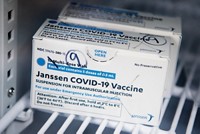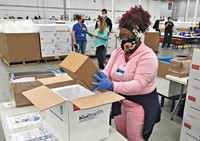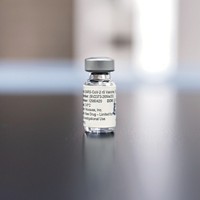Advertisement
Grab your lab coat. Let's get started
Welcome!
Welcome!
Create an account below to get 6 C&EN articles per month, receive newsletters and more - all free.
It seems this is your first time logging in online. Please enter the following information to continue.
As an ACS member you automatically get access to this site. All we need is few more details to create your reading experience.
Not you? Sign in with a different account.
Not you? Sign in with a different account.
ERROR 1
ERROR 1
ERROR 2
ERROR 2
ERROR 2
ERROR 2
ERROR 2
Password and Confirm password must match.
If you have an ACS member number, please enter it here so we can link this account to your membership. (optional)
ERROR 2
ACS values your privacy. By submitting your information, you are gaining access to C&EN and subscribing to our weekly newsletter. We use the information you provide to make your reading experience better, and we will never sell your data to third party members.
Support nonprofit science journalism
C&EN has made this story and all of its coverage of the coronavirus epidemic freely available during the outbreak to keep the public informed. To support us:
Donate Join Subscribe
Vaccines
Covid-19
Woes mount for AstraZeneca’s COVID-19 vaccine
Mixed messaging on the safety and efficacy of the shot threatens public confidence in the vaccine
by Ryan Cross
March 25, 2021
| A version of this story appeared in
Volume 99, Issue 11

Much of the world is counting on AstraZeneca’s COVID-19 vaccine to curb the pandemic. Countries have collectively ordered more doses of it than any other COVID-19 vaccine. Scientists say the shot is effective at preventing severe disease and death—the most important marker of a good vaccine. Based on adenoviral vector vaccine technology, the shot is cheaper to buy and easier to store than the mRNA vaccines made by Pfizer and Moderna, which must be kept in freezers.
By those measures, AstraZeneca’s vaccine should be a boon for beating the coronavirus. But the shot has been plagued by a series of safety scares, confusing clinical trial results, and communication blunders by its maker.
More than a dozen European countries recently halted administration of the shot after reports of rare blood clots in some vaccinated people, only to resume vaccination about a week later after regulators determined the shots were safe. And in the US, where the vaccine is not yet authorized, AstraZeneca released new clinical trial data that was at first praised—then quickly criticized for potentially exaggerating the shot’s effectiveness.
The common thread through AstraZeneca’s woes has been a lack of transparency, researchers say. Now they worry that the PR debacles are shattering public confidence in the shot and potentially spoiling what could still be a safe and effective tool for ending the pandemic.
“The science can be great, but if people won’t take the vaccine because communications are bad, what’s the point of having a good vaccine?” asks William K. Hallman, a psychologist at Rutgers University–New Brunswick and former chair of the US Food and Drug Administration’s Risk Communication Advisory Committee. “This will literally be a case study about what not to do.”
AstraZeneca’s vaccine, developed by scientists at the University of Oxford, was once on track to become the first COVID-19 shot authorized in the US. Trouble for the company began after it failed to tell the FDA about a participant that developed a neurological disease during a clinical trial of the vaccine last summer. The FDA paused the trial for 7 weeks in September and October but ultimately did not find a link between the disease and the vaccine.
More recently, rare blood clots in people who had recently received the vaccine in Europe—where it is already authorized for public use—prompted more than a dozen countries to halt administration of the vaccine. Of the more than 17 million people vaccinated with the shot in the UK and the EU, 37 developed blood clots. Scientists note that blood clots are common and that the rates seen in the vaccine recipients are not higher than what would be expected to occur normally. Although the European Medicines Agency (EMA) could not rule out a possible link between the vaccines and the clots, it said such a link was unlikely and emphasized the benefits of vaccination outweigh the risks.
Many scientist agreed with the EMA’s conclusion. “There is almost no indication that the vaccine increases the risk for blood clots,” says Hildegund C.J. Ertl, a vaccine scientist at the Wistar Institute.
But some researchers in Europe say that the EMA isn’t accounting for the specific kinds of blood clots that some vaccine recipients developed. Researchers told Science magazine that a more granular look at these cases suggests they are occurring at a higher-than-expected rate. To further complicate the issue, most people who developed blood clots are women.
“All of this information does not fit together in a nice neat package that allows people to decide if the vaccine is safe for them,” says Hallman, who worries that the debacle will fuel arguments against the vaccines. He says it is important to remember that people develop medical problems all the time, and inevitably some of these problems will arise soon after vaccination.
“Problems happen together in illusory patterns,” he says. “They look like they belong together, they look like a common cause, but they are essentially random events that we impose a pattern on. That may be the case with the AstraZeneca vaccine.”
Safety issues, real or perceived, are another strike against the AstraZeneca vaccine, which has often been portrayed as an inferior shot to the mRNA vaccines from Pfizer and Moderna. The mRNA vaccines are about 95% effective at preventing COVID-19. The effectiveness of AstraZeneca’s shot, in contrast, has been reported as high as 90% and as low as 22% depending on the location of the trial, the dosage of the vaccine, and the time between the two injections.
On March 22, days after the EMA tried to resolve the blood-clot debacle, AstraZeneca announced results from its Phase 3 trial of more than 32,000 people in the US, Peru, and Chile. According to the company, the vaccine was 79% effective at preventing symptomatic COVID-19 and 100% effective at preventing severe disease and hospitalization based on an analysis of 141 cases of COVID-19 among participants in the trial, mostly in the placebo arm. Researchers welcomed the positive news. “That level of protection is great,” Ertl says.
But later that night, the independent Data and Safety Monitoring Board responsible for assessing the vaccine data notified the US National Institutes of Health (NIH) that AstraZeneca may have painted an inaccurately rosy picture of its data. Soon after midnight on March 23, the NIH released a statement saying “that AstraZeneca may have included outdated information from that trial, which may have provided an incomplete view of the efficacy data.”
Researchers were shocked by the public disclosure. “It is extremely unusual for a Data Safety Monitoring Board to announce this in public. It is normally done behind closed doors,” Ertl says. The Washington Post reported that the most recent data from the trial suggests the vaccine is 69–75% effective—4 to 10 percentage points lower than what AstraZeneca reported.
“This business of them padding the numbers really shoots us in the foot,” says Tony Moody, an immunologist at the Duke Human Vaccine Institute. “People are finding enough reasons to not want to get a vaccine, and then a company does something like that—that is just dumb.”
In response the to the uproar, AstraZeneca said it would release new numbers based on the latest clinical trial data. On March 25, the company announced that its vaccine was 76% effective at preventing symptomatic COVID-19 based on an updated analysis that included 190 cases of the disease. The company also said its vaccine was 85% effective in adults 65 and older, and still 100% effective at preventing severe disease and hospitalization.
Ertl is also perplexed by the company’s decision to test two doses of its shot just 4 weeks apart. An analysis of the company’s earlier UK trial suggested that the vaccine was more effective when the administration of the two doses was spaced out. The vaccine was about 82% effective when the two shots were given 12 weeks or more apart, but only 55% effective when the time between the two shots was 6 weeks or less.
Those results are also hard to reconcile with the new US trial, which suggests AstraZeneca’s vaccine is 79% effective when the two shots are given 4 weeks apart.
Even if that 79% value turns out to be inflated, a vaccine that is 70% effective at preventing symptomatic disease could still be useful, Moody says. More importantly, he thinks the emphasis on how effective the vaccines are at preventing symptomatic disease—which includes mild and moderate cases—is overshadowing the more important result of this trial: the 100% protection against severe disease and death. “The vaccine looks like it is doing what we want it to do.”
AstraZeneca says it plans to submit data to the FDA in the coming weeks for authorization of its vaccine. The firm is likely to face a grilling from the vaccine advisory committee that votes on whether the agency should authorize the shots. The company will likely need to address the safety of its vaccines, the discrepancies in the numbers reported in its clinical trials, and whether the vaccine will be effective against new circulating variants of the coronavirus.
A trial in South Africa found that the shot was only 22% effective at preventing mild or moderate COVID-19 in the country, where a variant of the virus called B.1.351 is widely circulating. That variant, and others like it, are now in the US and other countries.
If the vaccine earns authorization for distribution in the US, it might not arrive in time to help curb the pandemic. The US government said it would have enough shots from Pfizer, Moderna, and Johnson & Johnson for every adult in the US by the end of May. It’s unclear what use, if any, will remain for AstraZeneca’s vaccine in the US. “It is a good question, and not one that we have a firm answer to,” Moody says. “Having more options is not a bad thing, especially one that doesn’t have the big cold chain issue like the Pfizer and Moderna vaccines do.”
The vaccine, with its lower cost and less-stringent storage requirements, is already helpful in low-income countries and could be useful in rural areas in the US. Researchers fear the repercussions of AstraZeneca’s debacle could negatively impact the national and global vaccine rollout.
“People who are skeptical about vaccines already will point to legitimate news articles and say that there are issues with this vaccine and therefore all vaccines,” Hallman says. “The way that the communications was handled just feeds into people’s worst intuitions about the speed with which these vaccines were put together and rolled out.”
“What makes me so sad is that this is a really good vaccine, but the way that they get across their messaging is just confusing everyone, including me,” Ertl says. “The science backs up the vaccine,” she adds. “A bad PR job should not undermine a good vaccine.”





Join the conversation
Contact the reporter
Submit a Letter to the Editor for publication
Engage with us on Twitter